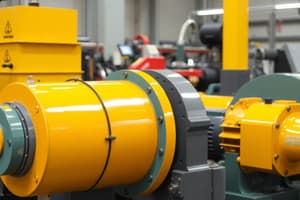Podcast
Questions and Answers
What is the primary characteristic of armature windings used in machines designed for low voltage and high current?
What is the primary characteristic of armature windings used in machines designed for low voltage and high current?
- They are constructed with small wire.
- They are connected in series.
- They are used in small generators.
- They are connected in parallel. (correct)
What is the effect of connecting windings in series in a wave winding armature?
What is the effect of connecting windings in series in a wave winding armature?
- The current capacity of each winding is added, providing a higher operating current.
- The number of parallel paths increases.
- The voltage of each winding adds, but the current capacity remains the same. (correct)
- The flux per pole increases.
What is the formula for the number of parallel paths in a lap winding armature?
What is the formula for the number of parallel paths in a lap winding armature?
- A = Z
- A = N/60
- A = 2
- A = P (correct)
What is the unit of flux per pole in the given equation?
What is the unit of flux per pole in the given equation?
What is the effect of increasing the number of poles in a generator on the generated EMF?
What is the effect of increasing the number of poles in a generator on the generated EMF?
What is the formula for the time for one revolution in the given equation?
What is the formula for the time for one revolution in the given equation?
What is the equation for the average EMF generated per conductor?
What is the equation for the average EMF generated per conductor?
What is the purpose of using large wire in lap winding armatures?
What is the purpose of using large wire in lap winding armatures?
What percentage of full load losses are typically due to armature copper losses?
What percentage of full load losses are typically due to armature copper losses?
What is the primary cause of windage losses in a DC machine?
What is the primary cause of windage losses in a DC machine?
What is the formula for shunt field copper losses?
What is the formula for shunt field copper losses?
What is the typical range of mechanical losses as a percentage of full load losses?
What is the typical range of mechanical losses as a percentage of full load losses?
What is the primary cause of friction losses in a DC machine?
What is the primary cause of friction losses in a DC machine?
What is the formula for armature copper losses?
What is the formula for armature copper losses?
What are the three main types of losses in a DC machine?
What are the three main types of losses in a DC machine?
Flashcards are hidden until you start studying
Study Notes
Armature Winding
- Armature Winding is classified into two types: Lap Winding and Wave Winding
Lap Winding
- Used in machines designed for low voltage and high current
- Armatures are constructed with large wire due to high current
- Examples: used in starter motors of almost all automobiles
- Windings are connected in parallel, which adds the current capacity of each winding and provides a higher operating current
- Number of parallel paths, A = P, where P is the number of poles
Wave Winding
- Used in machines designed for high voltage and low current
- Windings are connected in series, which adds the voltage of each winding but maintains the same current capacity
- Examples: used in small generators
- Number of parallel paths, A = 2
Generated EMF or EMF Equation of a Generator
- The equation for generated EMF (Eg) is based on the following variables:
- Φ = flux/pole in Weber
- Z = total number of armature conductors
- P = number of generator poles
- A = number of parallel paths in armature
- N = armature rotation in revolutions per minute (r.p.m)
- E = e.m.f induced in any parallel path in armature
- The average e.m.f generated per conductor is dΦ/dt volts
- The flux cut per conductor in one revolution is dΦ = ΦP wb
- The time for one revolution is dt = 60/N sec
- According to Faraday's Law of Electromagnetic Induction, the e.m.f generated per conductor is dΦ/dt = ΦPN/60 volts
D.C. Machines
- Speed below critical speed affects the machine's performance.
Effects of Change of Speed
- The shunt field resistance circuit has a greater resistance than the critical resistance.
Total Losses in a D.C. Machine
- Total losses in a D.C. machine consist of three types: copper losses, iron losses, and mechanical losses.
Copper Losses
- Copper losses occur due to current passing through the windings.
- There are three types of copper losses:
- Armature copper losses (30 to 40% of full load losses) = Ia²Ra, where Ra is the armature resistance and Ia is the armature current.
- Shunt field copper losses (20 to 30% of full load losses) = Ish²Rsh, where Rsh is the shunt field resistance and Ish is the shunt field current.
- Series field copper losses = Ise²Rse, where Rse is the series field resistance and Ise is the series field current.
- Losses due to brush contact resistance are usually included in armature copper losses.
Mechanical Losses
- Mechanical losses account for 10 to 20% of full load losses.
- There are two types of mechanical losses:
- Friction losses, which occur due to bearings.
- Windage losses, which occur due to the air gap between the armature and pole shoe.
Studying That Suits You
Use AI to generate personalized quizzes and flashcards to suit your learning preferences.




